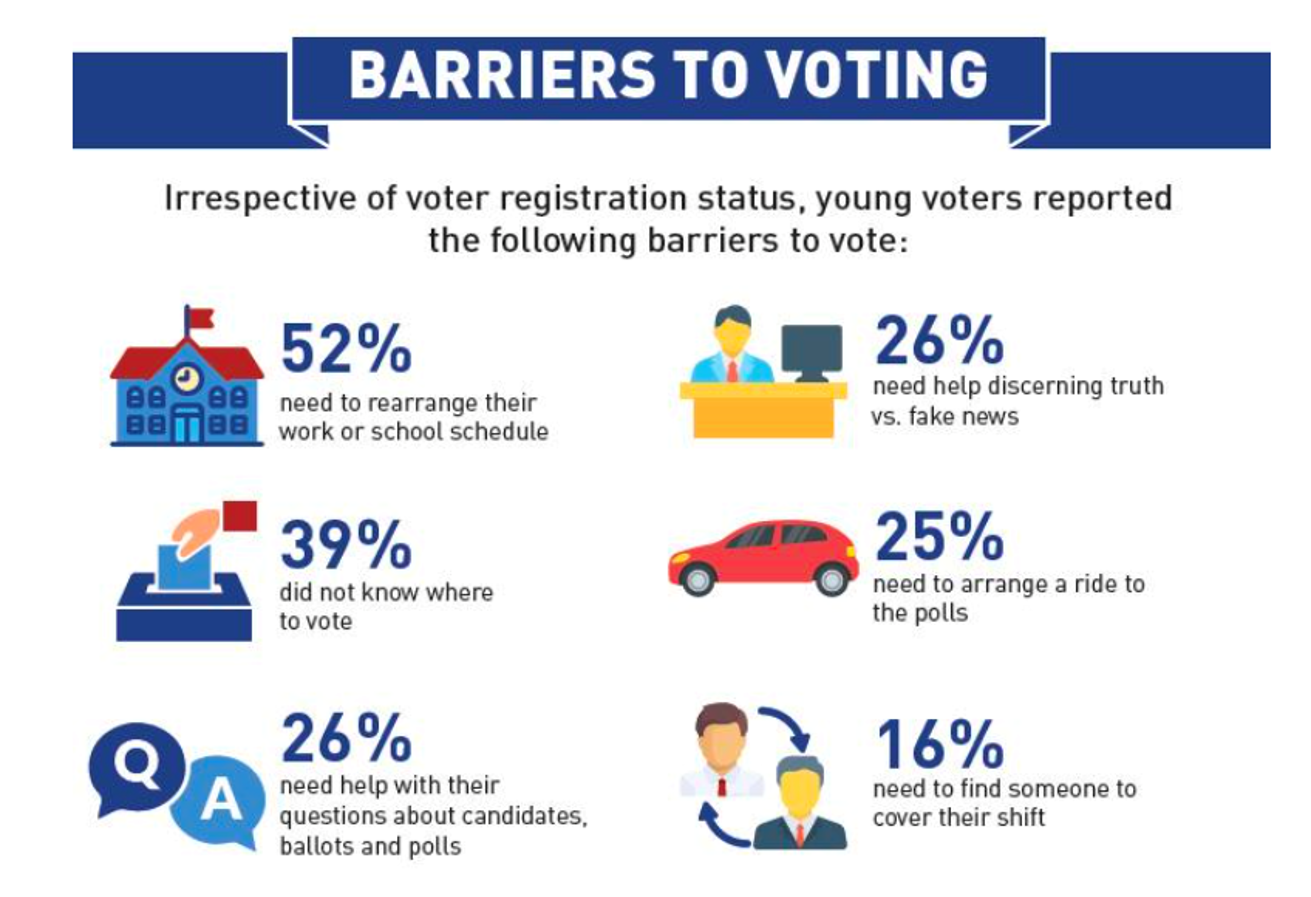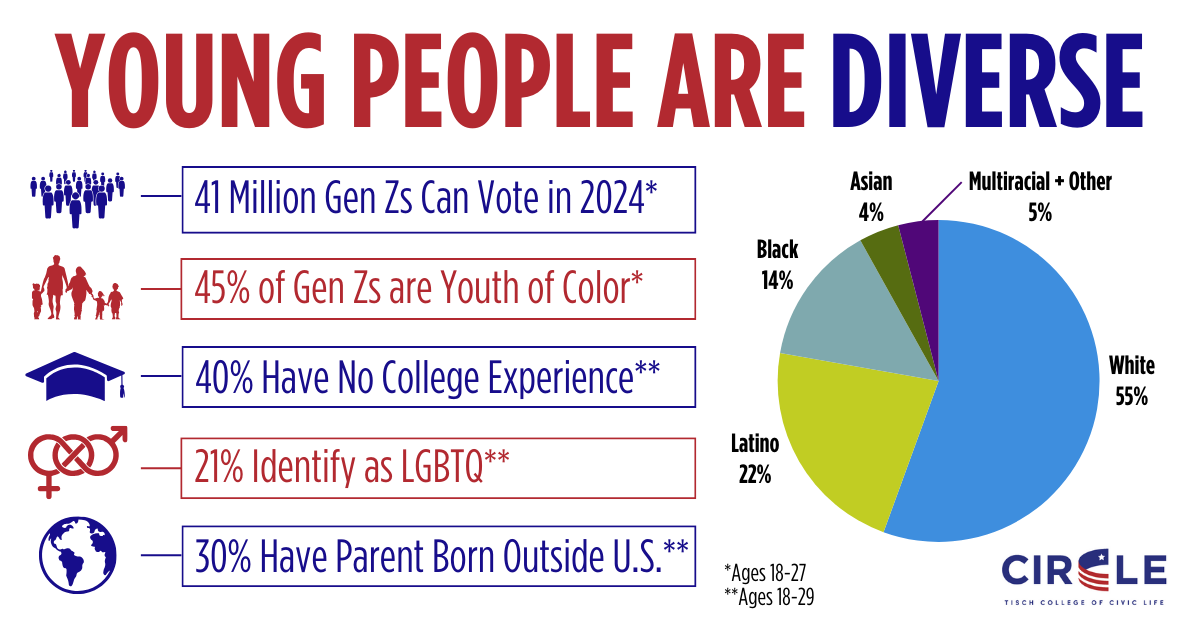Dispelling Myths about Youth Voting
When many members of the public talk about young people's civic and political participation, they often rely on and perpetuate myths about youth voting and youth attitudes toward civic life. These myths can reflect a lack of understanding of the complex dynamics that shape young people's engagement in democracy. At best, they paint an incomplete picture of these dynamics; at worst, they misrepresent them entirely.
CIRCLE's two decades of research on these topics, and our work on the ground with a diverse set of partners and practitioners, have given us the data and understanding to dispel some of these myths:
Young people care deeply about their communities, about issues, about their peers, and about achieving social change. If that commitment doesn't always translate to huge voter turnout says more about the barriers to youth electoral participation, and about the messages we do and don't send youth about their role in the political process.
Recent CIRCLE research has highlighted how youth civic and political engagement is strong and growing—especially among young women.
It’s true that younger people have historically voted at lower rates than older Americans. That's true not just for Millennials and Gen Z'ers, it was also true of Boomers and Gen X'ers when they were the youngest voters.
But youth turnout has been historically high in recent election cycles. It jumped from 39% in 2016 to 50% in 2020, and from 13% in 2014 to 28% in 2018. While it did not match that record-breaking turnout of the previous midterm, in 2022 Gen Z youth had a higher turnout rate than any previous generation in the first midterm election in which it made up the entirety of the 18-24 age group. The same was true in the 2020 presidential election.
If young people aren't apathetic, why do they vote at lower rates than older adults? In large part it's because they face formidable structural barriers to electoral participation. Many youth experience uneven and unequal civic education that doesn't teach them to vote or why their vote matters. Candidates and political parties tend to either ignore them or take them for granted; youth receive less campaign outreach than older adults. The media often perpetuates some of the myths on this page, shaping a culture that doesn't expect youth to vote and doesn't support youth in seeing themselves as valuable participants in democracy.
Then there's the logistical barriers: lack of transportation, long lines, no time off from work, convoluted absentee ballot requirements that trip up out-of-state college students, and efforts at voter suppression. After the 2022 election, when we asked youth why they didn't register or cast a ballot, only a minority said it did not matter or they didn't think it was important. The vast majority cited reasons and barriers related to lack of time and information.
In short: the story of why young people don't vote at higher rates is largely the story of a society that has not prepared them to do so and has not valued and facilitated their electoral engagement.


The current generation of young people is the most diverse in American history. That's true both in terms of race/ethnicity and in terms of their experiences. Narratives about youth—and particularly about young voters—often portray them as uniformly Democratic-leaning college students. For one thing, 40% of youth (ages 18-29) do not have any college experience; millions are already married and have children. Youth are also diverse in other ways: 30% have at least one parent born outside the United States, and more than 1 in 5 identify as LGBTQ+.

That diversity is reflected in the issues young people care about: while some media narratives portray youth as focused on college affordability/student loan debt and marijuana legalization, our polling has found that the top issues for youth are the environment, racial inequality, and affordable healthcare. Though—again reflecting young people's diversity—issue priorities vary based on race/ethnicity and other factors.
Likewise, while it's true that young voters have favored Democrats in the past few elections, that is a relatively recent trend and is not uniform across the country. In 7 of the last 12 presidential elections, young voters have either preferred the Republican candidate or favored the Democrat by less than 5 percentage points. Youth support for Democratic candidates has widened in recent years, but in 2020 former President Trump still “won” young voters, or was within 5 percentage points of President Biden, in nine states.
Because many incorrectly assume that youth do not vote in significant numbers, they may likewise think that young voters don't decide elections. This can create a vicious circle: political parties, campaigns, and other stakeholders think the youth vote won't help them win so they don't invest in reaching young people, and that lack of outreach depresses participation and feeds the narrative that young people don't show up and don't matter.
In 2016, young people cast many times more votes than the margin of victory in key states like Florida, Pennsylvania, Michigan and North Carolina, which effectively decided the election. In 2018, young people were the driving force behind a wave election for Democrats and helped decide key statewide races in states like Wisconsin, Nevada, and Montana. Young people of color played an especially influential role. The same was true in 2020, when young voters played a critical role in states like Arizona, Georgia, Pennsylvania, and Michigan.

